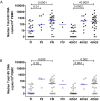A novel acute HIV infection staging system based on 4th generation immunoassay
- PMID: 23718762
- PMCID: PMC3669623
- DOI: 10.1186/1742-4690-10-56
A novel acute HIV infection staging system based on 4th generation immunoassay
Abstract
Background: Fourth generation (4thG) immunoassay (IA) is becoming the standard HIV screening method but was not available when the Fiebig acute HIV infection (AHI) staging system was proposed. Here we evaluated AHI staging based on a 4thG IA (4thG staging).
Findings: Screening for AHI was performed in real-time by pooled nucleic acid testing (NAT, n=48,828 samples) and sequential enzyme immunoassay (EIA, n=3,939 samples) identifying 63 subjects with non-reactive 2nd generation EIA (Fiebig stages I (n=25), II (n=7), III (n=29), IV (n=2)). The majority of samples tested (n=53) were subtype CRF_01AE (77%). NAT+ subjects were re-staged into three 4thG stages: stage 1 (n=20; 4th gen EIA-, 3rd gen EIA-), stage 2 (n=12; 4th gen EIA+, 3rd gen EIA-), stage 3 (n=31; 4th gen EIA+, 3rd gen EIA+, Western blot-/indeterminate). 4thG staging distinguishes groups of AHI subjects by time since presumed HIV exposure, pattern of CD8+ T, B and natural killer cell absolute numbers, and HIV RNA and DNA levels. This staging system further stratified Fiebig I subjects: 18 subjects in 4thG stage 1 had lower HIV RNA and DNA levels than 7 subjects in 4thG stage 2.
Conclusions: Using 4th generation IA as part of AHI staging distinguishes groups of patients by time since exposure to HIV, lymphocyte numbers and HIV viral burden. It identifies two groups of Fiebig stage I subjects who display different levels of HIV RNA and DNA, which may have implication for HIV cure. 4th generation IA should be incorporated into AHI staging systems.
Figures


References
-
- Ananworanich J, Schuetz A, Vandergeeten C, Sereti I, de Souza M, Rerknimitr R, Dewar R, Marovich M, van Griensven F, Sekaly R. Impact of multi-targeted antiretroviral treatment on gut T cell depletion and HIV reservoir seeding during acute HIV infection. PLoS One. 2012;7:e33948. doi: 10.1371/journal.pone.0033948. - DOI - PMC - PubMed
Publication types
MeSH terms
Substances
Grants and funding
LinkOut - more resources
Full Text Sources
Other Literature Sources
Medical
Research Materials

